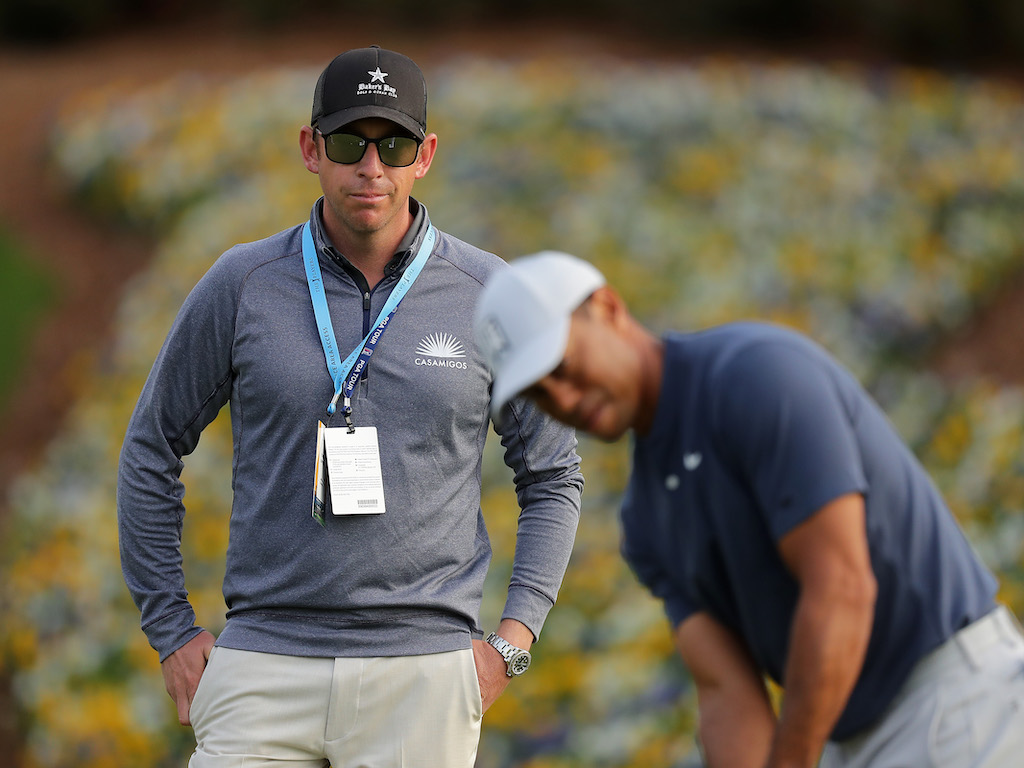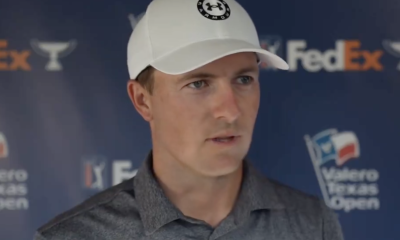Opinion & Analysis
Who is Matt Killen, Tiger Woods’ new putting coach?

It was over two years ago when I met Matt Killen at an airport in Toronto. I was just obnoxious enough to chase him down and introduce myself. I’m happy I did, he’s a great human being and has been a fun person to chat with Over the past couple of years. I have always been a big fan of his work and amazed that a young man could have so much success in what had always appeared to be an older man’s field. Today it was announced that Matt is now working with Tiger Woods on certain aspects of his game…..for any teacher that’s the pinnacle. The running narrative is if Tiger trusts your opinion, you must be on to something.
Here is an article I wrote for GolfWRX in September of 2016 on who Matt is and what makes him so special.
This week, the golfing world will descend upon Hazeltine National Golf Club in Chaska, Minnesota, for the 41st playing of the Ryder Cup. The media will keep busy in deep analysis on who will win, the role of the captain’s picks and other speculation. What’s rarely discussed, however, are the people who work behind the scenes to get the world’s best golfers firing on all cylinders to represent their countries: the swing coaches.
In the Ryder Cup’s storied past, the names of those who roamed the ranges read like a who’s who of golf tutelage: Butch Harmon, David Leadbetter, Pete Cowen and Phil Rodgers, to name a few. If you tune into the coverage this week, you might see a new “kid” on the block roaming the range, but the truth is he’s been on the scene for almost 10 years. And this upcoming Ryder Cup is not his first go around.
Matt Killen is on his second tour of duty, and the previous time he was at the Ryder Cup the U.S. won. Killen’s current stable includes young guns Justin Thomas, Patrick Rodgers, Bud Cauley and 2016 Ryder Cup captain’s pick J.B. Holmes, who Killen has worked with for more than 10 years. That’s almost as long as the void in U.S. victories in the Ryder Cup (sorry to bring that up). The interesting part is Killen, whose home base is The Concession Golf Club in Bradenton, Florida, turned 31 years old on Monday (let the math settle in). Yes, he’s been working with some of the best players in the world since before he could legally drink a beer.
During the 2008 Ryder Cup — a victorious endeavor for the U.S. — Killen was a busy man, as he had three different players in the event: fellow Kentucky natives J.B. Holmes and Kenny Perry, as well as Chad Campbell. Killen was also working with team captain Paul Azinger at the time — and Killen was only 22 years old! Most teachers and swing coaches don’t begin working with Tour players until well into their 30s, and many times much later. How does this happen, and what makes Killen the guy (read: kid) who Tour players trust with their careers?
On my way home from Toronto during the Canadian Open, I ran into Killen, whose story is every bit as compelling as the players he coaches. It was a random encounter at the Toronto airport, but I was compelled to introduce myself being hugely interested in his story. He’s a soft-spoken, Southern native with an overwhelming sense of confidence when he discusses golf mechanics. After a bit of small talk, we dug into his swing philosophies. I found myself dumbfounded with the ease in which he was able to explain body mechanics and clubface dynamics. That’s what the great teachers seemingly all have in common; their knowledge of the swing is ridiculously rich, but their ability to deliver the message simply and tailor it to the learning styles of each student is what breeds success.
Although the attention on our golfing prodigies always seems to focus on the players, being a swing coach to those players at such a young age is far more unlikely than winning on the PGA Tour. Young teachers are at a disadvantage based on experience and time. So how can a strong, trusting relationship be built with someone so young? After all, information in regards to the golf swing, especially at that level, always just seems a bit more reliable coming from the mouth of say a 40- or 50-year-old guy who has made the rounds in golf academies, and/or was a successful player in his own right.
Killen was just a skinny teenager who had the courage to speak up when his best friend’s father, Kenny Perry, was looking for something or someone to light the fire. With the burning passion of youth, Matt was the kid for the job. Most teenagers would have shied away from an intimidating situation like that. The saying, “Luck is what happens when preparation meets opportunity” never seemed more appropriate.
What’s Killen’s first point of focus when working with a top player?
“What’s gonna make them the most money?” Killen said.
A pretty honest answer if you ask me, especially for a 31-year-old. Killen first determines what a golfer is physically capable of doing and then establishes what’s possible, but the science and analysis behind Killen’s philosophy is anything but simple. He is well versed in body mechanics and the physics of impact, particularly gear effect, which he said is one of the main things his top players need to understand to remedy their misses.
“Most of these guys not only own their golf swings but also have a path and club face relationship that creates a predictable pattern with the ball flight they want,” Killen said. “With modern equipment, especially the driver, understanding how gear effect can confuse certain misses is vital to a player’s working knowledge.”
I dug a little deeper with Killen. What I found was that he’s not trying to construct analytical golfing machines. Like his pursuit for the truth behind what makes a golf ball fly a certain way, he asks that his players take on the responsibility of knowing exactly who they are as players, and accepting what they can and can’t do. Once that awareness and trust is built, the success can follow.
“You always want all your players to have the comfort level to play any shot that is required, and most of the guys out there can under all conditions,” Killen said. “What I work on with my guys is to take ownership of their swing and to understand shot for shot how and why the ball is flying a certain way so they can address it quickly and focus on shooting the scores they need to win.”
I was curious; does J.B. Holmes’ plan differ this week at the Ryder Cup than it would at a typical PGA Tour event? Not really, Killen said.
“Working with J.B. this week, I will be focusing on establishing a predictable pattern,” he said. “After we walk the course and look at all the shots required, we will focus on on any particular shot he isn’t 100 percent comfortable with. Our preparation will be process focused and when he tees it up his focus will be the shot at hand and staying athletic. J.B. is a pure feel player, but he is also a student that searches for understanding of his golf swing and is able to discern the information quickly while being able to react as an athlete once he’s between the ropes.”
Under Ryder Cup pressure, especially the past few years, the players who have thrived were the those who fell back on their natural instincts and played the shots that felt right to them. At the end of the day, that’s all Killen is trying to get his players to understand and execute. At the top level, it’s often the golfer who is most comfortable in his own skin that will prevail, and the only pathway to that is to take full ownership of your motion.
What I also found compelling about Killen and his staff is that each of his Tour players, regardless of physical stature, is within the top 30 in driving distance. That includes Bud Cauley, who is currently averaging 300.1 yards off the tee while standing at only 5-feet, 7-inches and 155 pounds.
Looking at the big picture, Killen is only one teacher working with one of the 24 players this week. But for me, and maybe for many of you after reading this article, it really runs deeper than that. Golf has become a sport that has attracted some of the most unique young talents in the sports world. And prodigies of the educational variety, although not as flashy as a 345-yard drives or green jackets, are just as impressive. Matt Killen will be on PGA Tour ranges for a long time — not because he has a new swing philosophy or the flashiest stable of players. It’s because like the men he teaches, it’s all he’s cared about his entire life. It’s a selfless pursuit, and not exactly the most glamorous path. Most young golfers wanted to play like Tiger when they were 12, but Killen just wanted to know how he played like he did.
Here’s to a great Ryder Cup, and when you see great shots made down the stretch, remember there’s a swing coach watching who had something to do them.
- LIKE144
- LEGIT11
- WOW10
- LOL1
- IDHT3
- FLOP7
- OB3
- SHANK18
Instruction
The Wedge Guy: The easiest-to-learn golf basic

My golf learning began with this simple fact – if you don’t have a fundamentally sound hold on the golf club, it is practically impossible for your body to execute a fundamentally sound golf swing. I’m still a big believer that the golf swing is much easier to execute if you begin with the proper hold on the club.
As you might imagine, I come into contact with hundreds of golfers of all skill levels. And it is very rare to see a good player with a bad hold on the golf club. There are some exceptions, for sure, but they are very few and very far between, and they typically have beat so many balls with their poor grip that they’ve found a way to work around it.
The reality of biophysics is that the body moves only in certain ways – and the particulars of the way you hold the golf club can totally prevent a sound swing motion that allows the club to release properly through the impact zone. The wonderful thing is that anyone can learn how to put a fundamentally sound hold on the golf club, and you can practice it anywhere your hands are not otherwise engaged, like watching TV or just sitting and relaxing.
Whether you prefer an overlap, interlock or full-finger (not baseball!) grip on the club, the same fundamentals apply. Here are the major grip faults I see most often, in the order of the frequency:
Mis-aligned hands
By this I mean that the palms of the two hands are not parallel to each other. Too many golfers have a weak left hand and strong right, or vice versa. The easiest way to learn how to hold the club with your palms aligned properly is to grip a plain wooden ruler or yardstick. It forces the hands to align properly and shows you how that feels. If you grip and re-grip a yardstick several times, then grip a club, you’ll see that the learning curve is almost immediate.
The position of the grip in the upper/left hand
I also observe many golfers who have the butt of the grip too far into the heel pad of the upper hand (the left hand for right-handed players). It’s amazing how much easier it is to release the club through the ball if even 1/4-1/2″ of the butt is beyond the left heel pad. Try this yourself to see what I mean. Swing the club freely with just your left hand and notice the difference in its release from when you hold it at the end of the grip, versus gripping down even a half inch.
To help you really understand how this works, go to the range and hit shots with your five-iron gripped down a full inch to make the club the same length as your seven-iron. You will probably see an amazing shot shape difference, and likely not see as much distance loss as you would expect.
Too much lower (right) hand on the club
It seems like almost all golfers of 8-10 handicap or higher have the club too far into the palm of the lower hand, because that feels “good” if you are trying to control the path of the clubhead to the ball. But the golf swing is not an effort to hit at the ball – it is a swing of the club. The proper hold on the club has the grip underneath the pad at the base of the fingers. This will likely feel “weak” to you — like you cannot control the club like that. EXACTLY. You should not be trying to control the club with your lower/master hand.
Gripping too tightly
Nearly all golfers hold the club too tightly, which tenses up the forearms and prevents a proper release of the club through impact. In order for the club to move back and through properly, you must feel that the club is controlled by the last three fingers of the upper hand, and the middle two fingers of the lower hand. If you engage your thumbs and forefingers in “holding” the club, the result will almost always be a grip that is too tight. Try this for yourself. Hold the club in your upper hand only, and squeeze firmly with just the last three fingers, with the forefinger and thumb off the club entirely. You have good control, but your forearms are not tense. Then begin to squeeze down with your thumb and forefinger and observe the tensing of the entire forearm. This is the way we are made, so the key to preventing tenseness in the arms is to hold the club very lightly with the “pinchers” — the thumbs and forefingers.
So, those are what I believe are the four fundamentals of a good grip. Anyone can learn them in their home or office very quickly. There is no easier way to improve your ball striking consistency and add distance than giving more attention to the way you hold the golf club.
More from the Wedge Guy
- The Wedge Guy: Golf mastery begins with your wedge game
- The Wedge Guy: Why golf is 20 times harder than brain surgery
- The Wedge Guy: Musings on the golf ball rollback
- LIKE83
- LEGIT13
- WOW5
- LOL1
- IDHT0
- FLOP4
- OB1
- SHANK8
19th Hole
Vincenzi’s 2024 Texas Children’s Houston Open betting preview

As the Florida swing comes to an end, the PGA Tour makes its way to Houston to play the Texas Children’s Houston Open at Memorial Park Golf Course.
This will be the fourth year that Memorial Park Golf Course will serve as the tournament host. The event did not take place in 2023, but the course hosted the event in 2020, 2021 and 2022.
Memorial Park is a par-70 layout measuring 7,432 yards and features Bermudagrass greens. Historically, the main defense for the course has been thick rough along the fairways and tightly mown runoff areas around the greens. Memorial Park has a unique setup that features three Par 5’s and five Par 3’s.
The field will consist of 132 players, with the top 65 and ties making the cut. There are some big names making the trip to Houston, including Scottie Scheffler, Wyndham Clark, Tony Finau, Will Zalatoris and Sahith Theegala.
Past Winners at Memorial Park
- 2022: Tony Finau (-16)
- 2021: Jason Kokrak (-10)
- 2020: Carlos Ortiz (-13)
In this article and going forward, I’ll be using the Rabbit Hole by Betsperts Golf data engine to develop my custom model. If you want to build your own model or check out all of the detailed stats, you can sign up using promo code: MATTVIN for 25% off any subscription package (yearly is best value).
Key Stats For Memorial Park
Let’s take a look at several metrics for Memorial Park to determine which golfers boast top marks in each category over their last 24 rounds:
Strokes Gained: Approach
Memorial Park is a pretty tough golf course. Golfers are penalized for missing greens and face some difficult up and downs to save par. Approach will be key.
Total Strokes Gained: Approach per round in past 24 rounds:
- Tom Hoge (+1.30)
- Scottie Scheffler (+1.26)
- Keith Mitchell (+0.97)
- Tony Finau (+0.92)
- Jake Knapp (+0.84)
Strokes Gained: Off the Tee
Memorial Park is a long golf course with rough that can be penal. Therefore, a combination of distance and accuracy is the best metric.
Total Strokes Gained: Off the Tee per round in past 24 rounds:
- Scottie Scheffler (+0.94)
- Kevin Dougherty (+0.93)
- Cameron Champ (+0.86)
- Rafael Campos (+0.84)
- Si Woo Kim (+0.70)
Strokes Gained Putting: Bermudagrass + Fast
The Bermudagrass greens played fairly fast the past few years in Houston. Jason Kokrak gained 8.7 strokes putting on his way to victory in 2021 and Tony Finau gained in 7.8 in 2022.
Total Strokes Gained Putting (Bermudagrass) per round past 24 rounds (min. 8 rounds):
- Adam Svensson (+1.27)
- Harry Hall (+1.01)
- Martin Trainer (+0.94)
- Taylor Montgomery (+0.88)
- S.H. Kim (+0.86)
Strokes Gained: Around the Green
With firm and undulating putting surfaces, holding the green on approach shots may prove to be a challenge. Memorial Park has many tightly mowed runoff areas, so golfers will have challenging up-and-down’s around the greens. Carlos Ortiz gained 5.7 strokes around the green on the way to victory in 2020.
Total Strokes Gained: Around the Green per round in past 24 rounds:
- Mackenzie Hughes (+0.76)
- S.H. Kim (+0.68)
- Scottie Scheffler (+0.64)
- Jorge Campillo (+0.62)
- Jason Day (+0.60)
Strokes Gained: Long and Difficult
Memorial Park is a long and difficult golf course. This statistic will incorporate players who’ve had success on these types of tracks in the past.
Total Strokes Gained: Long and Difficult in past 24 rounds:
- Scottie Scheffler (+2.45)
- Ben Griffin (+1.75)
- Will Zalatoris (+1.73)
- Ben Taylor (+1.53)
- Tony Finau (+1.42)
Course History
Here are the players who have performed the most consistently at Memorial Park.
Strokes Gained Total at Memorial Park past 12 rounds:
- Tyson Alexander (+3.65)
- Ben Taylor (+3.40)
- Tony Finau (+2.37)
- Joel Dahmen (+2.25)
- Patton Kizzire (+2.16)
Statistical Model
Below, I’ve reported overall model rankings using a combination of the five key statistical categories previously discussed.
These rankings are comprised of SG: App (24%) SG: OTT (24%); SG: Putting Bermudagrass/Fast (13%); SG: Long and Difficult (13%); SG: ARG (13%) and Course History (13%)
- Scottie Scheffler
- Wyndham Clark
- Tony Finau
- Joel Dahmen
- Stephan Jaeger
- Aaron Rai
- Sahith Theegala
- Keith Mitchell
- Jhonnatan Vegas
- Jason Day
- Kurt Kitayama
- Alex Noren
- Will Zalatoris
- Si Woo Kim
- Adam Long
2024 Texas Children’s Houston Open Picks
Will Zalatoris +2000 (Caesars)
Scottie Scheffler will undoubtedly be difficult to beat this week, so I’m starting my card with someone who I believe has the talent to beat him if he doesn’t have his best stuff.
Will Zalatoris missed the cut at the PLAYERS, but still managed to gain strokes on approach while doing so. In an unpredictable event with extreme variance, I don’t believe it would be wise to discount Zalatoris based on that performance. Prior to The PLAYERS, the 27-year-old finished T13, T2 and T4 in his previous three starts.
Zalatoris plays his best golf on long and difficult golf courses. In his past 24 rounds, he ranks 3rd in the category, but the eye test also tells a similar story. He’s contended at major championships and elevated events in the best of fields with tough scoring conditions. The Texas resident should be a perfect fit at Memorial Park Golf Club.
Alex Noren +4500 (FanDuel)
Alex Noren has been quietly playing some of his best golf of the last half decade this season. The 41-year-old is coming off back-to-back top-20 finishes in Florida including a T9 at The PLAYERS in his most recent start.
In his past 24 rounds, Noren ranks 21st in the field in Strokes Gained: Off the Tee, 30th in Strokes Gained: Around the Green, 25th in Strokes Gained: Total on long and difficult courses and 21st in Strokes Gained: Putting on fast Bermudagrass greens.
In addition to his strong recent play, the Swede also has played well at Memorial Park. In 2022, Noren finished T4 at the event, gaining 2.2 strokes off the tee and 7.0 strokes on approach for the week. In his two starts at the course, he’s gained an average of .6 strokes per round on the field, indicating he is comfortable on these greens.
Noren has been due for a win for what feels like an eternity, but Memorial Park may be the course that suits him well enough for him to finally get his elusive first PGA Tour victory.
Mackenzie Hughes +8000 (FanDuel)
Mackenzie Hughes found himself deep into contention at last week’s Valspar Championship before faltering late and finishing in a tie for 3rd place. While he would have loved to win the event, it’s hard to see the performance as anything other than an overwhelming positive sign for the Canadian.
Hughes has played great golf at Memorial Park in the past. He finished T7 in 2020, T29 in 2021 and T16 in 2022. The course fit seems to be quite strong for Hughes. He’s added distance off the tee in the past year or and ranks 8th in the field for apex height, which will be a key factor when hitting into Memorial Park’s elevated greens with steep run-off areas.
In his past 24 rounds, Hughes is the best player in the field in Strokes Gained: Around the Greens. The ability to scramble at this course will be extremely important. I believe Hughes can build off of his strong finish last week and contend once again to cement himself as a President’s Cup consideration.
Akshay Bhatia +8000 (FanDuel)
Akshay Bhatia played well last week at the Valspar and seemed to be in total control of his golf ball. He finished in a tie for 17th and shot an impressive -3 on a difficult Sunday. After struggling Thursday, Akshay shot 68-70-68 in his next three rounds.
Thus far, Bhatia has played better at easier courses, but his success at Copperhead may be due to his game maturing. The 22-year-old has enormous potential and the raw talent to be one of the best players in the world when he figures it all out.
Bhatia is a high upside play with superstar qualities and may just take the leap forward to the next stage of his career in the coming months.
Cameron Champ +12000 (FanDuel)
Cameron Champ is a player I often target in the outright betting market due to his “boom-or-bust” nature. It’s hard to think of a player in recent history with three PGA Tour wins who’s been as inconsistent as Champ has over the course of his career.
Despite the erratic play, Cam Champ simply knows how to win. He’s won in 2018, 2019 and 2021, so I feel he’s due for a win at some point this season. The former Texas A&M product should be comfortable in Texas and last week he showed us that his game is in a pretty decent spot.
Over his past 24 rounds, Champ ranks 3rd in Strokes Gained: Off the Tee and 30th in Strokes Gained: Total on long and difficult courses. Given his ability to spike at any given time, Memorial Park is a good golf course to target Champ on at triple digit odds.
Robert MacIntyre +12000 (FanDuel)
The challenge this week is finding players who can possibly beat Scottie Scheffler while also not dumping an enormous amount of money into an event that has a player at the top that looks extremely dangerous. Enter McIntyre, who’s another boom-or-bust type player who has the ceiling to compete with anyone when his game is clicking on all cylinders.
In his past 24 rounds, MacIntyre ranks 16th in the field in Strokes Gained: Off the Tee, 17th in Strokes Gained: Around the Green and 10th in Strokes Gained: Total on long and difficult courses.
MacIntyre’s PGA Tour season has gotten off to a slow start, but he finished T6 in Mexico, which is a course where players will hit driver on the majority of their tee shots, which is what we will see at Memorial Park. Texas can also get quite windy, which should suit MacIntyre. Last July, the Scot went toe to toe with Rory McIlroy at the Scottish Open before a narrow defeat. It would take a similar heroic effort to compete with Scheffler this year in Houston.
Ryan Moore +15000 (FanDuel)
Ryan Moore’s iron play has been absolutely unconscious over his past few starts. At The PLAYERS Championship in a loaded field, he gained 6.1 strokes on approach and last week at Copperhead, he gained 9.0 strokes on approach.
It’s been a rough handful of years on Tour for the 41-year-old, but he is still a five-time winner on the PGA Tour who’s young enough for a career resurgence. Moore has chronic deterioration in a costovertebral joint that connects the rib to the spine, but has been getting more consistent of late, which is hopefully a sign that he is getting healthy.
Veterans have been contending in 2024 and I believe taking a flier on a proven Tour play who’s shown signs of life is a wise move at Memorial Park.
- LIKE15
- LEGIT1
- WOW1
- LOL0
- IDHT0
- FLOP0
- OB0
- SHANK2
Opinion & Analysis
Ryan: Why the race to get better at golf might be doing more harm than good

B.F. Skinner was one of the most important psychologists of the 20th century, developing the foundation of the development of reinforcement, and in doing so, creating the concept of behaviorism. In simple terms, this means that we are conditioned by our habits. In practical terms, it explains the divide between the few and far between elite instructors and college coaches.
To understand the application, let’s quickly review one of B.F. Skinner’s most important experiments; superstitions in the formation of behavior by pigeons. In this experiment, food was dispensed to pigeons at random intervals. Soon, according to Skinner, the pigeons began to associate whatever action they were doing at the time of the food being dispensed. According to Skinner, this conditioned that response and soon, they simply haphazardly repeated the action, failing to distinguish between cause and correlation (and in the meantime, looking really funny!).
Now, this is simply the best way to describe the actions of most every women’s college golf coach and too many instructors in America. They see something work, get positive feedback and then become conditioned to give the feedback, more and more, regardless of if it works (this is also why tips from your buddies never work!).
Go to a college event, particularly a women’s one, and you will see coaches running all over the place. Like the pigeons in the experiment, they have been conditioned into a codependent relationship with their players in which they believe their words and actions, can transform a round of golf. It is simply hilarious while being equally perturbing
In junior golf, it’s everywhere. Junior golf academies make a living selling parents that a hysterical coach and over-coaching are essential ingredients in your child’s success.
Let’s be clear, no one of any intellect has any real interest in golf — because it’s not that interesting. The people left, including most coaches and instructors, carve out a small fiefdom, usually on the corner of the range, where they use the illusion of competency to pray on people. In simple terms, they baffle people with the bullshit of pseudo-science that they can make you better, after just one more lesson.
The reality is that life is an impromptu game. The world of golf, business, and school have a message that the goal is being right. This, of course, is bad advice, being right in your own mind is easy, trying to push your ideas on others is hard. As a result, it is not surprising that the divorce rate among golf professionals and their instructors is 100 percent. The transfer rate among college players continues to soar, and too many courses have a guy peddling nefarious science to good people. In fact, we do at my course!
The question is, what impact does all this have on college-age and younger kids? At this point, we honestly don’t know. However, I am going to go out on a limb and say it isn’t good.
Soren Kierkegaard once quipped “I saw it for what it is, and I laughed.” The actions of most coaches and instructors in America are laughable. The problem is that I am not laughing because they are doing damage to kids, as well as driving good people away from this game.
The fact is that golfers don’t need more tips, secrets, or lessons. They need to be presented with a better understanding of the key elements of golf. With this understanding, they can then start to frame which information makes sense and what doesn’t. This will emancipate them and allow them to take charge of their own development.
- LIKE14
- LEGIT5
- WOW1
- LOL2
- IDHT0
- FLOP1
- OB0
- SHANK11
-

 19th Hole2 weeks ago
19th Hole2 weeks agoJohn Daly stuns fans into silence with brutal opening tee shot on PGA Tour Champions
-

 19th Hole6 days ago
19th Hole6 days agoThings got heated at the Houston Open between Tony Finau and Alejandro Tosti. Here’s why
-

 19th Hole3 days ago
19th Hole3 days agoReport: Tiger Woods has ‘eliminated sex’ in preparation for the 2024 Masters
-

 19th Hole2 weeks ago
19th Hole2 weeks ago2-time major champ announces shock retirement from the sport at age of 33
-

 19th Hole3 weeks ago
19th Hole3 weeks agoEdoardo Molinari reveals the latest PGA Tour golfer to turn down ‘good offer’ from LIV Golf
-

 19th Hole2 weeks ago
19th Hole2 weeks agoCharlie Woods finds it tough going on American Junior Golf Association debut
-

 19th Hole3 weeks ago
19th Hole3 weeks agoScottie Scheffler had an interesting response when asked how he ‘quiets the noise’ following Players victory
-

 19th Hole5 days ago
19th Hole5 days agoAddiction, spinal fusion, and scam artists – Everything Anthony Kim revealed in candid interview with David Feherty



























smashdn
Mar 15, 2019 at 12:15 pm
I’ve known Matt for a long time. He was actually one of my first friends when my family moved here. While he has obviously gone and done his own thing since high school I still count him as a friend. As down to earth a dude as you can meet that will make time to talk with you about golf despite the level of guys he coaches.
CrashTestDummy
Mar 14, 2019 at 9:07 pm
Tiger’s putting mechanics look spot on. He looks like he is hitting his putts where he wants. I think his putting issues are more about misreading putts or just a mental issue than mechanics just like Jordan Spieth. Spieth’s mechanics haven’t changed since he was a phenomenal putter it is just a mental issue that he needs to overcome. However, a coach can just give them that confidence and reaffirm that they are doing the right things which can change their entire mental state and belief. That could be the edge to turn the tides.
Jon
Mar 14, 2019 at 8:59 am
I am not a professional putting coach by any stretch of the imagination, nor a guru, but can explain “things” quite well and am patient (so I am told!). I have worked with a PGA pro on his putting. The guy could putt serious lights out and really just wanted to understand more about the things that he could not explain or see for himself. He basically did not want to go to the “names” because he had concluded they were a rip-off and they always “upsell” and try to get you to introduce them to people you know. He says I improved his putting by helping him understand a bit more what was going on. I say it looked almost exactly the same to me but it is all in the mind with these guys and if you can find something that clicks, and they try it, you are a guru. It’s just a confidence building thing with them. they haven’t got to where they are by luck.
joro
Mar 13, 2019 at 6:19 pm
So the question is does the Coach make the player, or does the player make the coach. Face it, all these guys were really good before the Coach, why know do they need one and several of them found a Coach and haven’t been heard from since.
Tim
Mar 21, 2019 at 10:59 am
I think Tiger tried to prove that point by moving around to different coaches, feeling they may have been getting too much credit for his success.
Where would Pelz and Stockton be without Mickelson? Good teachers and working sure, but they built their brand off of Phil. Phil still gets streaky with the putter and his short game helped Pelz more than Pelz helped him.
Milton Taylor
Mar 13, 2019 at 2:35 pm
Perhaps the greatest clutch putter of all times needs a putting coach… Good grief, He just can’t help himself. He has to have a coach.
Ben Murphy
Mar 13, 2019 at 12:40 pm
Why does any professional golfer, much less Tiger Woods, need a “putting” trainer?
Putting is about the easiest part of golf! You’re really messed up if you can’t putt
anymore.
Jack Nash
Mar 13, 2019 at 8:27 am
Nobody heard of Matt until, of course, he stands behind Tiger. The guy’s a phenom nobody heard about “until”.
Ralph
Mar 12, 2019 at 11:01 pm
how can u get a lesson with this guy?
Dan
Mar 13, 2019 at 12:36 pm
first you will need a bank loan…haha